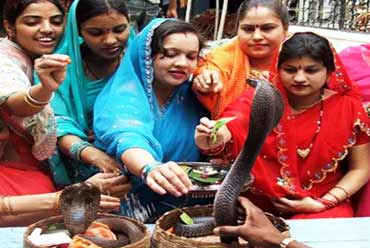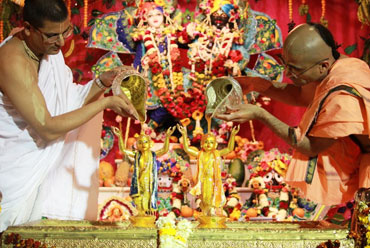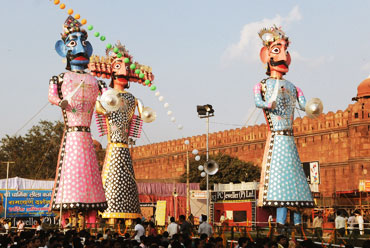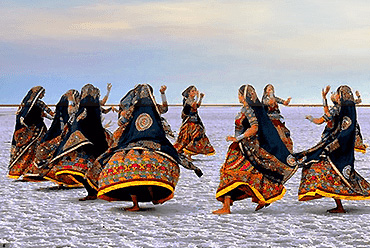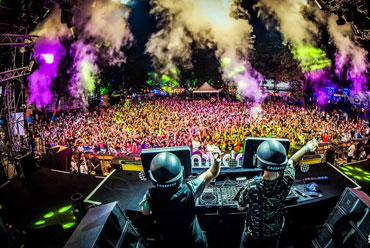Every year, after the monsoon has washed away the heat and dust of the summer, a colorful procession-Phoolwalon-ki-Sair or the procession of the flower-sellers-winds it way down the flower-sellers' promenade in Mehrauli. Led by shehnai players and dancers, it moves from the temple of Jog Maya, through the Mehrauli Bazaar to place curtains made of flowers on the tomb of Saint Qutubuddin Bakhtiyar Kaki. This is one of the few festivals in which both Hindus and Muslims participate with equal fervor.
Phoolwalon-ki-Sair or the Sair-e-Gulafroshan, a three-day festival, is observed by practically everyone in Mehrauli. It is celebrated simultaneously at the dargah of Khwaja Bakhtiyar Kaki and at the ancient shrine of Devi Jog Maya. Floral tributes are offered at both places. Kathak dances, qawwalis, a blaze of lights, huge pankhas (fans) made of palm leaves, decorated with tinsel and flowers, and acrobats delight a vast audience. A huge procession, led by fire dancers, takes the flower pankhas through the streets of Mehrauli.
Celebrations
The cultural programme takes place at the Jahaz Mahal (ship palace) built by the Lodhis on the banks of the Shamsi Talab (once a large pool) at the end of the Mehrauli Bazaar. Not far from there, behind the tomb of Adham Khan (Emperor Akbar's foster brother), stands the temple of Jog Maya, after which Delhi was once known as Yoginipura. Nothing remains of this temple now except the name and the stone idol.
Muslims come from distant places on pilgrimage to Khwaja Kaki's tomb. Kaki or Qutub sahib earned the sobriquet Kaki because during his long hours of meditation, he sometimes forgot to eat and had to be fed with cakes called kaki. He succeeded Muenuddin of Ajmer as the head of the Chishtiya order of Sufis. People still tie colored strings on the trelliswork of the dargah to beg favors of the saint. On his death anniversary, qawwalis are sung and the poor are fed. Village boys entertain visitors by jumping into an adjoining bauli (well) from seemingly dizzy heights.
On the first day of the festival, the procession of fans and flowers starts from the Jharna (a beautiful garden with cascades and fountains built by Feroz Shah Tughlak) with musicians, athletes demonstrating sports and fencing, and soldiers in their colorful uniforms. It passes through the brilliantly lit Mehrauli Bazaar to the Jog Maya Mandir. The next day, another elaborate procession takes shape and weaves its way to the tomb of Khwaja Bakhtiyar Kaki.
What began as a Muslim women's obeisance in gratitude at the shrine of a Muslim saint, has, over centuries, become an occasion of pilgrimage and celebration for the whole city, transcending barriers of community and class. In the olden days, the king used to go both to the tomb of Khwaja Bakhtiyar and to the Jog Maya Mandir and the Muslims and Hindus alike followed him. The famous poet, Mirza Ghalib, referred to the secular nature of the festival saying, "In this city, is a festival called the flower men's festival. Everyone in the city from the nobles to the artisans goes off to the Qutub Minar. There they stay for two or three weeks. All the shops in the city of Muslims and Hindus alike stay closed throughout this time"
Phoolwalon-ki-Sair became an annual celebration and something that the people looked forward to every year in the months following the monsoon. In 1942, at the time of the Quit India Movement, the British suspended the festival for reasons of security. But Pandit Jawaharlal Nehru, who responded instinctively to its beauty and gaiety, re-instituted the festival in 1962. Since then, history is beautifully re-enacted every year in the form of this procession of flower-sellers.
Legends
But how did the Phoolwalon-ki-Sair begin? Its history goes back to the days of the Mughal Emperor Akbar Shah II in the 19th century. Bahadur Shah Zafar was the prince chosen by the British to succeed Akbar Shah II. But the latter was persuaded by his favorite Queen, Mumtaz Mahal to change his decision in favor of her son, Mirza Jahangir. The British did not agree. Mirza Jahangir was a spirited but spoilt boy who, to show his resentment against the British, took a shot at Seton, the British resident in the Mughal court. The attempt failed and only Seton's hat was knocked off, but the British, annoyed with Mirza Jahangir, exiled him to Allahabad. His grieving mother then took a vow that if her son was allowed to return to Delhi, she would make an offering of a four-poster flowerbed at the holy shrine of Khwaja Bakhtiyar Kaki at Mehrauli.
After some time, the British agreed to Mirza Jahangir's return to Delhi but only after the King guaranteed his good behavior and agreed not to question Zafar's status as the heir apparent. Mirza Jahangir returned amidst great fanfare and his mother began elaborate preparations to fulfill her vow. A beautiful flower canopy was created to which the flower-sellers added an elaborate flower pankha at their own cost. Both these were then ceremoniously carried in a large procession to the saint's tomb.
However, Mirza Jahangir, an incurable alcoholic, did not change his ways. He was exiled again and finally died in Allahabad at the age of 31. But the pilgrimage of the court and the people of Delhi to Mehrauli became an annual event.
The popularity of the festival reached its peak during Bahadur Shah Zafar's reign. The King, Queen and the entire court would leave Delhi in palanquins a few days before the festival. They visited the tombs of Humayun, Safdarjung, and Hazrat Nizamuddin Aulia and then moved on to Mehrauli to accredit a reception. The Jahaz Mahal, near the dargah of Khwaja Bakhtiyar Kaki, now in ruins, was richly decorated with carpets and chandeliers for the occasion in those times. The King went to the Jharna the next day-where, in the seclusion of kanats and curtains, the court ladies relaxed. Whenever there was a drizzle, the royal party moved to the Amarian, a mango grove to the east of the Jhama, and a beautiful picnic spot. Here, delicacies of the season were prepared by the royal ladies themselves.
Regional Celebrations
Being celebrated only in Delhi, the Capital of India, the event is mainly confined to the Mehrauli Bazaar area of Delhi.

